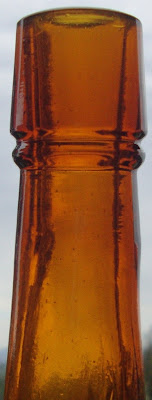The other day Bill,
a friend of mine from northern Cal. Co. with the high base kick-up and
the #"16" embossed in the center of the base dome. I've only had a
couple over the years. One still resides on my shelf, while the other was sold
as soon as it came in.
We got to talking
about the Roth, and it's four "cousins" who share the same odd base.
They include the McLeod & Faus, Mohns & Keltenbach (Eagle Glen), Seegelken
& Buckner and Weil Bros.
We both remarked
about how illusive (or elusive - depending on your mind set), these bottles are and that the mystery of who made these
bottles has remained unsolved all these years. That's when Bill said, "If anybody can figure it out, it will be you". Not sure if that was a challenge or a
compliment, but it sure got me to thinking.
Since
there are no real clues to work off of, I figured that I'd start with the
obvious; the years that each firm was in business. I referred to both the
Langely and the Crocker / Langely San Francisco directories and came up with
the following years that each firm appeared, and subsequently disappeared from
the listings, as well as the business address listed at their inception;
McLeod & Faus /
74 1st Street

Eagle Glen / Mohns & Keltenbach /
1895 - 1900

Roth & Co. /
Seegelken & Buckner / 821
Weil Bros. &
Sons (note Weil Bros, sans Sons, dates back to 1869) / 213 Jackson
The addresses had
no relevance but... the dating of the bottle was a no brainer. The only year
that all five of these firms existences overlapped was 1895.
Oddly, this year
also coincides with the peak of the German Connection clear and red amber glop
tops that Abramson and Heunisch were importing to the west coast from Europe , which were being produced by Gerresheimer
Glasshuttenwerk. Unfortunately it is probably just that, mere coincidence. The
glass coloration of the so called "16" base cylinders is vastly different. With the exception of the S&B, the
style of the tapered collar tops, whether tooled or applied, seem abnormally elongated as opposed to GC production. The tops of both tooled and applied, appear to have been finished with the same tool. The embossing fonts and styles don't even come close to the
German cylinders. Dead end there?
All five are
virtually identical in terms of mold construction. There is no air venting
visible on any of the molds. The circular slug plate, that contained the
embossing patterns are identical in dimensions when measured with a dial
caliper. The embossing fonts present on the SeeGelken & Buckner and Eagle Glen / Mohns & Keltenbach are a match. The G is very
distinctive. In addition, the slanted "AND" is one in the same on the
preceding two, plus the McLeod and Faus. The font style of the lettering on the
McLeod & Faus, Roth & Co, and Weil
Bros. & Sons are a match. And, as mentioned, the tops are also virtually identical. The Eagle Glen and the Seegelken and Buckner are
a very light yellow / orange amber. The other three are a shade of lighter
orange amber. This would indicate that at least two different batches of glass
were used in the production process.
Unfortunately, no
one responded to our appeal for information on east coast bottles that may be a
match. The only online reference to a similar base mark was found on "Glass
bottle marks". It mentions a "16S marking, mostly on the lower heel area on
soda and beer bottles, and attributes it to American Bottle Company, at their
Streator, Illinois Toulouse
What we
do know is that a convincing case can be made that all five rear half molds and base
plates are identical, the slug plate insert were all utilized in the same front half
molds, the same individual (or individuals) cut the embossing, and that the
same tools were used to finish the tops, regardless if they were tooled or
applied. And, there's no denying that all five bottles were produced during the
year of 1895. The base marks are identical, although I'm now convinced that
instead of " '16", it's actually "91." . My guess is that
they are eastern in origin due to the style of the top and the coloration of
the glass.

Just
where these bottles were actually blown, however, remains a mystery.






























1 comment:
Why wouldn't you consider them to be a product made at S.F. & P.G.W ?
Post a Comment